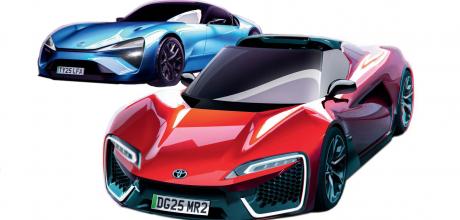Toyota MR2, Lexus LFA Electric future mapped out
EV rebirth for Toyota MR2 and Lexus LFA. Roadster and supercar part of Toyota’s bold electrification plan.
Scoop: Toyota MR2 is back!
Toyota is ramping up to electrify its growing Gazoo Racing performance brand following the launch of the new GR86 sports coupé – and it’s poised to bring back the MR2 as a lithe and compact two-seat EV with affordability at the forefront of its agenda. The roll-out of Toyota’s flat-floored E-TNGA modular EV architecture – as first deployed on the Toyota bZ4X and closely related Subaru Solterra and Lexus RZ SUVs – gives the Japanese firm the flexibility needed to maintain an offering in every segment as it electrifies.
Late last year, Toyota hinted at the diversity of its future electric line-up by unwrapping a fleet of 15 concept EVs (four of them from premium brand Lexus), including a diminutive urban crossover, a Tesla Model 3-rivalling saloon, a full-size pick-up truck and the aggressively styled Sports EV concept, which is expected to evolve into a modern-day MR2, the brand’s first bespoke electric sports car.
The future of Gazoo Racing has been thrown into the spotlight following Toyota’s shock announcement that it plans to launch 30 new EVs by 2030 – among the more ambitious electrification pledges of any mainstream manufacturer – and the revelation that the already-acclaimed GR86 will be in production for just two years, because it falls foul of forthcoming European crash-safety regulations. Toyota has been vocal in recent months about its belief that battery power is not the only approach the car industry can take to decarbonisation – particularly so Gill Pratt, CEO of the Toyota Research Institute – and it has emphasised its continued commitment to hydrogen fuel cell powertrains and even reworked some of its existing performance motors to run on hydrogen. But with a readymade skateboard BEV architecture on the table and a fast-improving international charging network to cater to owners of such cars, an all-electric two-seater fits logically into the firm’s line-up. Toyota is also hard at work on the development of production-ready solid-state batteries, which by virtue of their increased power density are both lighter and more efficient than the conventional lithium ion batteries in most EVs on sale today, and that makes them perfect for use in smaller and more dynamically focused sports cars.
Whether Gazoo’s debut EV will be the recipient of these new-era cells remains to be seen, but intriguingly the proportions of the targa-topped Sports EV concept – which appear realistic enough to be carried through to production largely unaltered – look to mirror the mid-engined silhouette of the EV’s spiritual predecessor, the MR2.
‘Mid-engined’ EVs are technically possible; Porsche and Lotus will stack batteries vertically behind the seats in the successors to the 718 Cayman and Elise respectively in a bid to centralise their mass within the chassis and thus emulate the handling traits of their petrol predecessors. Whether the new EV will stay true to the ‘R’ part of the MR2’s name is unclear. The earlier sports car’s rear-drive layout and optimised weight distribution were central to its charismatic dynamics, but so far the E-TNGA platform has been used only for front and rear-wheel-drive cars, so it would be more likely to provide the basis for a dedicated sports EV platform, rather than being carried over wholesale or with lightly repackaged drive systems.
LEXUS READIES EVIJA RIVAL
Toyota’s shift to all-out electrification also paves the way for Lexus to return to the world of full-bore supercars, replacing the howling V10-engined LFA of 2010-2012 with a futuristic and long-range rival to the Lotus Evija, Rimac Nevera and Pininfarina Battista.
A radically different proposition to Toyota’s sporting EV, Lexus’s imposing super-EV is targeting a range of 435 miles – courtesy of solidstate battery technology – and a 0-62mph time of less than 2.5sec, which could make it both one of the quickest and longest-legged EVs on sale when it arrives by 2030. Given that it’s likely to still be several years before Lexus reveals a production-ready version of the supercar, its technical details remain well under wraps. But the brand has given the first hints that it’s lining up other platforms – separate to the E-TNGA of the RZ – for use in its cars.
Speaking to DrivesToday recently, the firm’s European director, Spiros Fotinos, said: “The platform must deliver for Lexus with a focus on driving engagement. If that means an existing Toyota platform, a shared modified platform or an exclusive platform, none of those are on or off the table.”
Toyota is also hard at work developing solid-state batteries
The original LFA took six years to develop and commanded a whopping £340,000 price tag – but we deemed it a bona fide Ferrari-beater. Lexus engineers will no doubt be looking for ways to compensate for the absence of a screaming 9000rpm V10.
The new MR2 could be almost peerless as a mainstream EV sports car, but its predecessor had to contend with the might of the Mazda MX-5, MG F and even BMW and Mercedes roadsters. Its mid-mounted engine made it a winner in our eyes, though, and the EV looks to follow suit.


